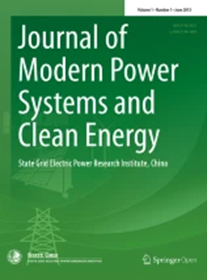Unbalanced Voltage Suppression of Bipolar DC Microgrids with Integration of DC Zero-Carbon Buildings
IF 5.7
1区 工程技术
Q1 ENGINEERING, ELECTRICAL & ELECTRONIC
Journal of Modern Power Systems and Clean Energy
Pub Date : 2024-04-23
DOI:10.35833/MPCE.2023.000713
引用次数: 0
Abstract
Considering the majority of electrical equipment utilized in society is driven by DC, integrating a DC system can significantly enhance the efficiency and reliability of power systems by implementing the integration of diverse loads, renewable energy sources (RESs), and energy storage systems (ESSs). In this paper, the integration of multiple DC zero-carbon buildings (DC-ZCBs) is proposed to achieve the unbalanced voltage suppression of the bipolar DC microgrid (DCMG). The photo-voltaic (PV) technology, loads, and DC electric springs (DC-ESs) are adopted as a unified entity to achieve the zero-carbon emission of the building. Firstly, a new configuration of PV and DC-ESs is introduced. The energy management of PV, ESS, and load are fully considered in this new configuration, which can reduce the capacity of the ESS. Subsequently, a distributed co-operative control strategy for DC-ESs based on the modulus voltage is presented, which is implemented with integration of the new configuration into the bipolar DCMG. The proposed approach addresses the issues of unbalanced voltage to improve the operating efficiency and power quality of the bipolar DC-MG. The simulation is conducted in MATLAB/Simulink platform to confirm the effectiveness of the proposed approach.集成直流零碳建筑的双极直流微电网不平衡电压抑制
考虑到社会上使用的大多数电气设备都是由直流驱动的,集成直流系统可以通过实现各种负载、可再生能源(RESs)和储能系统(ess)的集成,显著提高电力系统的效率和可靠性。本文提出了多个直流零碳建筑(DC- zcb)的集成,以实现双极直流微电网(DCMG)的不平衡电压抑制。光伏(PV)技术、负载和直流电动弹簧(DC- ess)作为一个统一的实体,实现了建筑的零碳排放。首先,介绍了一种新的光伏和直流- ess结构。新配置充分考虑了光伏、ESS和负载的能量管理,可以减少ESS的容量。在此基础上,提出了一种基于电压模量的DC-ESs分布式协同控制策略,并将该策略集成到双极DCMG中实现。该方法解决了电压不平衡的问题,提高了双极DC-MG的工作效率和电能质量。在MATLAB/Simulink平台上进行了仿真,验证了所提方法的有效性。
本文章由计算机程序翻译,如有差异,请以英文原文为准。
求助全文
约1分钟内获得全文
求助全文
来源期刊

Journal of Modern Power Systems and Clean Energy
ENGINEERING, ELECTRICAL & ELECTRONIC-
CiteScore
12.30
自引率
14.30%
发文量
97
审稿时长
13 weeks
期刊介绍:
Journal of Modern Power Systems and Clean Energy (MPCE), commencing from June, 2013, is a newly established, peer-reviewed and quarterly published journal in English. It is the first international power engineering journal originated in mainland China. MPCE publishes original papers, short letters and review articles in the field of modern power systems with focus on smart grid technology and renewable energy integration, etc.
 求助内容:
求助内容: 应助结果提醒方式:
应助结果提醒方式:


